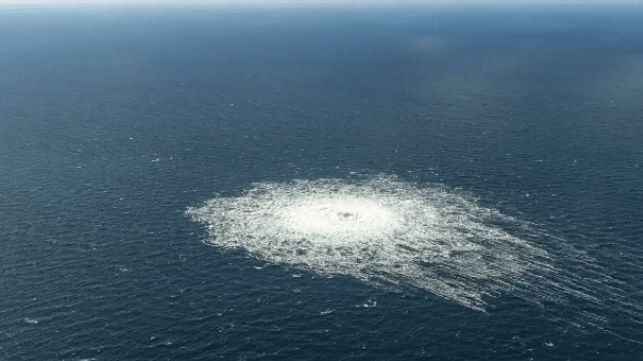Video: First Imagery of Blast Damage to the Nord Stream Pipelines

Swedish newspaper Expressen has released the first published images of the blast damage to Gazprom's Nord Stream subsea pipeline system.
Using a miniature ROV operated by BlueEye Robotics, Expressen surveyed at least one leak site on the Nord Stream 1 pipeline compex. (The Nord Stream 1 and Nord Stream 2 "pipelines" each have two physical pipes, four in total.)
The brief video clearly shows a splinter of fractured steel peeled away from the pipeline wall, not pushed inwards towards the interior. The line is cleanly severed through its circumference, and a 150-foot section of the four-foot-wide, inch-thick steel pipe was "missing" from the site, according to Expressen.
????The video of the destroyed section of the Nord Stream gas pipeline is published pic.twitter.com/zTFJa07zyO
— AZ ???????????????? (@AZgeopolitics) October 18, 2022
Four separate penetrations of the Nord Stream 1 and 2 pipeline complexes occurred in close succession on September 26. Three out of four pipes were ruptured, leaving one single pipe of the Nord Stream 2 complex intact. All were full at the time of the damage, and the gas took about one week to drain out, delaying the start of an investigation. The incident is believed to be the largest methane release in history.
On Tuesday, a Danish police investigative team said that it has concluded that "powerful explosions" were responsible for the blast. Sweden's Security Service announced a similar conclusion of "gross sabotage" caused by "detonations" earlier this month.
Dmitr Alperovich, chairman of the Silverado Policy Accelerator and a frequent commentator on the Russian invasion of Ukraine, noted Tuesday that the blasts did not necessarily have to originate outside of the pipeline. For an actor with access to the pipe's interior, it would be possible to deliver an explosive charge from the inside using an inspection crawler or similar device. This attack method would not require any operations in the water column, reducing the odds of detection.
The governments of Poland and Ukraine have accused the government of Russia, the main beneficial owner of Nord Stream 1 and 2, of carrying out the attack. The Kremlin has denied involvement and has blamed the United State government.
Russia has demanded access to the ongoing investigations into the blasts, but Denmark and Sweden have so far denied its requests.
